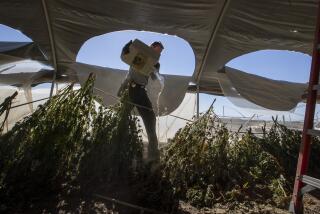The Hemp Crusade’s Guilt by Association
- Share via
When I ran across the word in some English novel, I had no idea what it was, but it sounded gorgeous, and I can still approximate the sentence: “It was the privilege of a peer of the realm, upon being found guilty of a capital offence, to be hanged by a silken rope rather than a common hempen one.”
Hempen--what a sublime word. But what the heck did it mean?
Therein lies, or hangs, the tale. Hempen is the adjective form of hemp, and hemp used to mean an abundant cash crop cultivated throughout the country for fiber, rope, canvas, paper. Now it means guilt by association, because in almost every characteristic except the one that can get you high, hemp is virtually the same plant from whence comes marijuana, cannabis sativa.
Hemp used to be ubiquitous, practically the polyester of its day, and its day lasted for centuries. It was woven into sailing canvas, maybe the very sails that brought the Mayflower here and covered the Conestoga wagons. It made the hawsers of the U.S. Navy. It was used in making paper, allegedly the paper on which a draft of the Constitution was written. It was even employed as recently as last year in Orange County, in the gilded plaster that spruced up Knott’s Berry Farm’s replica of Independence Hall, and lightning did not strike the workers dead.
The Agriculture Department once issued bulletins on the merit of hemp as paper stock and noted that, in 1916, California grew 1,400 tons of it. Popular Mechanics touted its usefulness in lace and linoleum and cellophane and as a domestic crop that could supplant the need for imported hemp. That was in February 1938. By the end of that year, the federal government had decided that despite the fact that industrial hemp might retain less than 1% of THC, the get-high ingredient of the dope variety of cannabis, that was enough to make it dangerous, and so it shut down every hemp factory except the one making rope for the Navy.
The demonizing of industrial hemp--its blurring with dope-grade marijuana--continues, even as foreign markets grow it and make use of it in car dashboards and jeans and plastics, even as U.S. farmers sue for the right to grow it again in Kentucky, where hemp was once as profitable as tobacco and may be again.
Perhaps hemp’s chief proselytizer is its one-man Chautauqua circuit, Richard M. Davis, curator and owner of the U.S.A. Hemp Museum, a traveling exhibit that, between gigs, lives with Davis in an apartment in West Los Angeles.
*
Richard Davis began his hemp collection after a friend gave him an American flag made of hemp fiber. He haunted junk stores for hempen goods and set up his card table exhibits outside the Westwood federal building and the state Capitol. (One item he doesn’t own is in a Ventura museum: a hemp apron made by Chumash Indians.)
“The history of hemp,” Davis says, “is that this country wouldn’t be here without it. All of us came on sailing ships with ropes of hemp. Before the cotton gin, most clothes were hemp or linen--homespun is actually hemp. You can grow it in your back yard.”
So important was hemp in World War II that after the Japanese occupied the Philippines and other countries that had supplied hemp, U.S. farmers were encouraged to grow it as a patriotic crop for the duration; Davis has an old newsreel, “Hemp for Victory,” extolling it. A young pilot named George Bush bailed out to safety under a parachute secured by hemp ropes.
Davis secured a master’s in biology from Cal State L.A. and did doctoral work in public health at UCLA. From his research, he learned to make hemp cardboard and paper, making hemp oil into paint and varnish at his own kitchen table.
Among industrial hemp’s promoters in this country, and their numbers are growing, Davis ranks as a smart man and a committed one.
But here is hemp’s twofold problem:
In an anti-drug political climate that equates marijuana with heroin, hemp stands convicted of guilt by association as the innocuous variety of the same plant that joints are made of. An ad company pressured by the DARE anti-drug group recently pulled 106 Southern California bus bench ads it had placed for a shampoo maker that uses hemp in the shampoo and, fatally, a cannabis leaf in its advertising.
The other obstacle is hemp’s own legion of supporters. In opposing industrial hemp, the nation’s drug czar charges that it is merely a stalking horse for legalizing drug-grade marijuana. And indeed, Davis was a pot-grower in Mendocino County for years and will tell anyone who asks that he has smoked it almost every day for 30 years--except recently, because he is on probation for selling cannabis in Arizona, where he got busted just as a judge was overturning the state’s law allowing dealers to peddle cannabis once they had received sales licenses through the Department of Revenue. Oscar Wilde said famously that each man kills the thing he loves, and the sad reality of American marketing is this:
Industrial hemp is not likely to become legal and accepted so long as its most vigorous supporters do not resemble the farm couple in “American Gothic,” who looked about as straight and sober as anyone can be and still be counted among the living.
More to Read
Sign up for Essential California
The most important California stories and recommendations in your inbox every morning.
You may occasionally receive promotional content from the Los Angeles Times.











